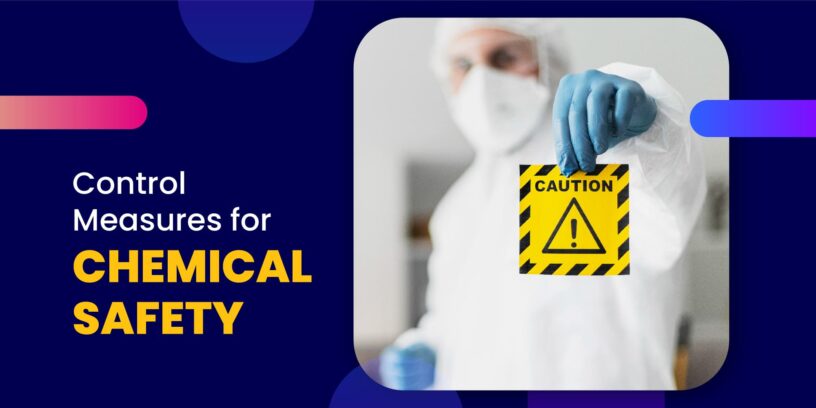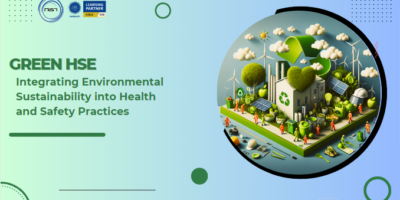Dealing with dangerous substances of any kind has numerous possible risks. No workplace can be completely free from chemical exposure hazards, not even with the strictest safety regulations in place. Because of this, it’s crucial to establish and maintain an efficient hierarchy of control for chemical safety in your workplace—a system that implements preventative procedures to guarantee that all personnel working with chemicals is safe. We’ll go over how to create such a hierarchy in this blog article so that everyone may handle hazardous materials safely.
There are numerous methods for reducing the dangers of hazardous chemicals. Some measures of control are more effective than others. Control measures are evaluated from top to lowest in terms of protection and dependability. This is referred to as the hierarchy of control.
Always prioritise the elimination of a danger and its associated risk. If risk persists, it must be reduced by applying administrative controls to the greatest extent possible. Any residual danger must be mitigated with appropriate personal protective equipment (PPE).
Administrative control methods and personal protective equipment (PPE) rely on human behaviour and supervision and are the least effective way of reducing hazards when used alone.
#1 Eliminating the Hazard
It entails eliminating the risk or risky work behaviour from the workplace. The most effective control measure should always be taken into account before other options. For instance, refraining from using a hazardous chemical or reducing exposure by
- Using nails as opposed to chemical-based adhesives
- Purchasing pre-mixed or diluted chemicals rather than manually diluting or mixing chemicals at the workplace will eliminate handling activities and potential worker exposure.
#2 Reduce or Substitute
Substitution is the replacement of a hazardous chemical with a less hazardous chemical that has less risks, such as:
- To control a vapour hazard, using a less volatile material may be less expensive than installing and maintaining a mechanical ventilation system.
- Substituting a highly flammable liquid for a less flammable or combustible liquid
- Utilizing hazardous substances with a single hazard class rather than several hazard classes.
- Substituting less dangerous compounds for high-hazard chemicals such as carcinogens, mutagens, reproductive toxicants, and sensitizers.
- Utilizing diluted acids and alkalis rather than concentrated acids and alkalis
- Utilizing a substance as a paste or pellet rather than dust or powder.
#4 Engineering Controls
Mechanical devices or procedures that eliminate or decrease chemical generation, suppress or confine chemicals, or limit the area of contamination in the event of spills and leaks are examples of engineering controls. They frequently include partial enclosure, exhaust ventilation, or process automation. Here are some examples of engineering controls:
- In dangerous environments, use electrical equipment that is intrinsically safe.
- Employing robots to reduce operator exposure, such as in coating tasks.
- Spray booths or fume cabinets that are only partially enclosed and ventilated.
- Ensure the ventilation booth is completely enclosed
- Local exhaust ventilation is used to catch airborne contaminants near their source.
Local exhaust ventilation is intended to catch airborne contaminants near to the site of generation. This stops them from polluting the workplace. The ventilation should be designed to keep contaminants out of the operator’s breathing zone.
Recirculation should be avoided unless procedures are made to identify and avoid dangerous contamination and to prevent the accumulation of airborne contaminants. Recirculation should be employed only when temperature control is essential.
#5 Administrative Controls
Administrative controls should be used only when other higher-order control methods are ineffective or to enhance other control measures. Administrative restrictions should only be utilised to provide additional protection against carcinogens.
Administrative controls are also useful in situations when other control mechanisms fail, such as controlling spills and leaks, and are especially crucial for staff who are expected to clean up spills or perform routine cleaning and maintenance. Administrative controls include the following:
- Policies and work practises are documented
- lowering the number of employees that are exposed to the chemical
- Reducing the time and/or frequency of worker exposure by using particular work practises (for example, job rotation).
- Just-in-time ordering rather than stockpiling huge quantities of hazardous chemicals and quick disposal of hazardous chemicals that are no longer needed can both help reduce the amount of hazardous chemicals present in the environment.
- Establishing processes that restrict access to high-risk areas to employees who are involved in the use, storage, handling or generation of hazardous substances.
- Putting systems in place to prevent the entrance of ignite sources into potentially dangerous regions.
- Reducing the time it takes for a chemical to escape into the workplace
- Good housekeeping and routine cleaning of work environments are examples of safe work practises.
- Modifying the material of the packaging to reduce exposure during handling
- To suppress dust formed during dry sweeping, use vacuuming or wet treatments.
- While not in use, keep hazardous chemical containers tightly closed.
- Spills should be cleaned up right away.
- Quick removal of residues from empty containers containing dangerous substances.
- Eating, drinking, and smoking are prohibited in potentially polluted places.
- Offering washing facilities for chemical rinsing
- To properly apply administrative controls, training and supervision should constantly be provided.
#6 Personal Protective Equipment (PPE)
Overalls, aprons, footwear, gloves, chemical-resistant eyewear, face shields, and respirators are examples of personal protective equipment (PPE). PPE should not be relied on to control risk in most situations. It should only be used as a last resort after all other reasonably practicable control measures have been exhausted and the risk has not been eradicated, or as a temporary remedy until higher-level controls are installed. Such measures may also be ineffective in some scenarios.
- Using chemical-resistant gloves provides the best resistance to the chemical being utilised. Some solvents may be resistant to some gloves but not others.
- During spray-painting activities, using a full-face, air-fed respirator rather than a half-face respirator decreases exposure to dangerous compounds such as isocyanates, which can induce skin and respiratory allergic reactions.














Leave a Reply